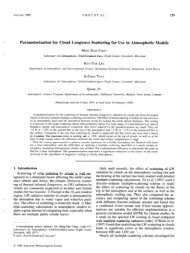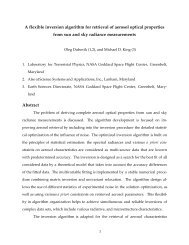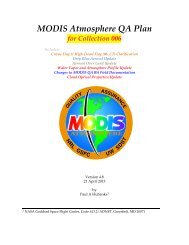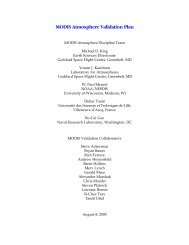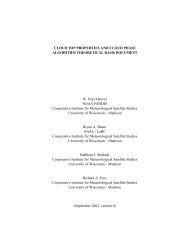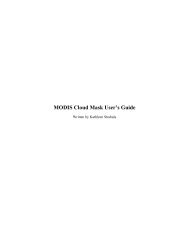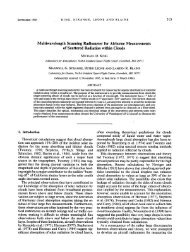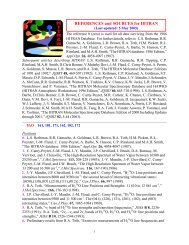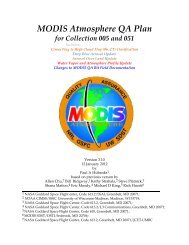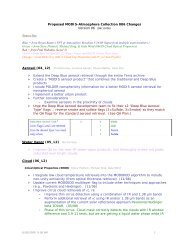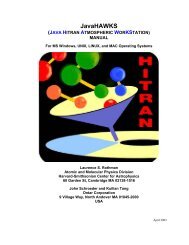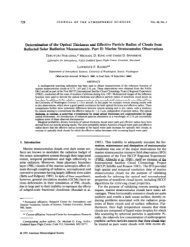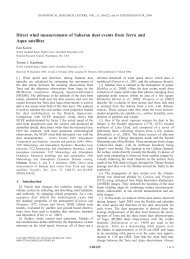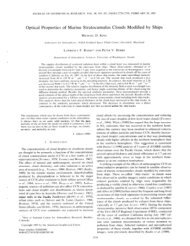Ackerman_et_al. - MODIS Atmosphere - NASA
Ackerman_et_al. - MODIS Atmosphere - NASA
Ackerman_et_al. - MODIS Atmosphere - NASA
Create successful ePaper yourself
Turn your PDF publications into a flip-book with our unique Google optimized e-Paper software.
1080 JOURNAL OF ATMOSPHERIC AND OCEANIC TECHNOLOGY VOLUME 25<br />
TABLE 2. Comparison of <strong>MODIS</strong> cloud d<strong>et</strong>ection with the<br />
ARSCL over the ARM site of the SGP.<br />
ARCL clear ARCL cloudy<br />
<strong>MODIS</strong> clear Terra: 146 Terra: 45<br />
Aqua: 117 Aqua: 58<br />
<strong>MODIS</strong> cloudy Terra:38 Terra: 298<br />
Aqua:12 Aqua: 185<br />
clear. Figure 10 plots the average confidence level of<br />
these cases as a function of the standard deviation of<br />
the <strong>MODIS</strong> confidence level in the group of pixels<br />
around the ARM site. Those observations that are<br />
d<strong>et</strong>ermined by <strong>MODIS</strong> as cloudy while ARCL is indicating<br />
clear are mostly associated with the average<br />
<strong>MODIS</strong> confidence flag near 0.90 (Fig. 10), where we<br />
have defined a v<strong>al</strong>ue of greater than 0.95 as clear. The<br />
low standard deviation indicates that the scenes are<br />
likely to be uniform, suggesting errors in the <strong>MODIS</strong><br />
classification.<br />
Those cases in which <strong>MODIS</strong> defines clear and ARSCL<br />
defines cloudy are explored in Fig. 11 by plotting the<br />
ARSCL cloud <strong>al</strong>titude versus the average ARSCL<br />
cloud fraction over the 30-min sampling period. Discrepancies<br />
occur for low cloud fractions, but these are<br />
not the majority of cases. Most differences occur for<br />
cloud-top <strong>al</strong>titudes greater than 8 km, suggesting that<br />
<strong>MODIS</strong> is missing some cirrus. The <strong>MODIS</strong> sensitivity<br />
to cirrus is greatest over the topic<strong>al</strong> waters and thick<br />
veg<strong>et</strong>ation as the R 1.38 threshold can be s<strong>et</strong> low and<br />
variations of the IR window surface emissivity are<br />
sm<strong>al</strong>l. In the midlatitudes, lower water vapor amounts<br />
and spectr<strong>al</strong> variations of the surface make d<strong>et</strong>ection of<br />
thin cirrus more difficult.<br />
FIG. 10. <strong>MODIS</strong> average confidence level vs std dev for cases<br />
labeled by <strong>MODIS</strong> as cloudy and by the ARSCL <strong>al</strong>gorithm as<br />
clear. The clear-sky confidence threshold is 0.95.<br />
FIG. 11. ARSCL cloud fraction as a function of cloud height for<br />
those cases labeled as clear by the <strong>MODIS</strong> <strong>al</strong>gorithm.<br />
The difference in cloud d<strong>et</strong>ection rates for high<br />
clouds raises the issue of <strong>al</strong>gorithm sensitivity to cloud<br />
optic<strong>al</strong> depth. Next, we d<strong>et</strong>ermine the minimum cloud<br />
optic<strong>al</strong> depth that the <strong>MODIS</strong> <strong>al</strong>gorithm can flag as<br />
cloudy.<br />
b. Optic<strong>al</strong> depth sensitivity<br />
We take two independent approaches to estimating<br />
cloud optic<strong>al</strong> d<strong>et</strong>ection limits: 1) compare observations<br />
of the <strong>MODIS</strong> Airborne Simulator (MAS) taken on<br />
board a high-<strong>al</strong>titude aircraft with coincident lidar observations<br />
and 2) compare cloud mask results from the<br />
<strong>MODIS</strong> cloud mask with ground-based measurements<br />
of visible optic<strong>al</strong> depth from the Arctic High-Spectr<strong>al</strong><br />
FIG. 12. The number of occurrences that a MAS pixel was identified<br />
as clear, but the CPL (McGill <strong>et</strong> <strong>al</strong>. 2002) d<strong>et</strong>ected a cloud<br />
with a given cloud optic<strong>al</strong> depth.



